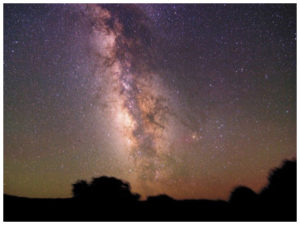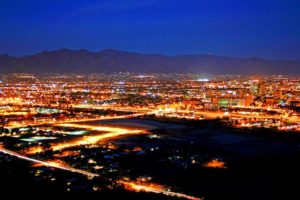From the beginning of life on earth, its rhythms have been dictated by the rising and setting of the sun. This ended on December 31, 1879, when Thomas Edison’s light bulbs first lit up a New York street. From that moment on, night started turning into day.
When an earth quake blacked-out all of Los Angeles in 1994, the emergency centers were flooded with calls from people reporting a “giant silvery cloud” in the night sky. What they saw, for the very first time in their lives, was the Milky Way.

According to a study published in Advance science magazine, there is now so much artificial light around the globe, that one third of mankind cannot see the Milky Way anymore. That includes 80% of all Americans.
Tucsonians are exceptional in this respect too. The Tucson area has long been attractive to astronomers because of it’s clear, dark night sky. Astronomy creates thousands of jobs in Arizona and brings some 250 billion dollars into the states economy.
But it is getting harder to catch those faint flickers of light from way across the universe. The steady increase in population means more artificial light spread out over a greater area, although Tucson’s progressive light ordinances have kept a rein on the increase in output.

It are not only the astronomers who are negatively affected by artificial light. Trees and plants have problems adjusting to the seasons when exposed to artificial light for prolonged periods, which again affects the wildlife depending on them, altering behavior, migration patterns, and breeding cycles. It throws off their clocks, so to say.
What, then, about humans?
Our sleep rhythms regulate the production of certain hormones, such as melatonin, that govern the synchronization of many periodic physiological functions, like blood pressure and blood sugar levels. Disturbance of these so-called circadian rhythms has been linked to high blood pressure and diabetes. And to cancer. Cancer, after all, is badly timed cell division.
There is,a significantly higher incidence of breast cancer among women working night shifts, and it has been associated with prostate cancer in men as well. Moreover, artifical light is also considered as a factor in a number of mental disorders.
For eons living cells have synced their on-board clocks to the sequence of night and day. When that line is blurred, their timing goes off. The fact that sunlight is unidirectional, while artificial light comes from all directions at once, may also be a factor.
Unavoidably, light pollution is going to increase in tandem with the population, but all things considered, it is in everybody’s interest to keep it at a minimum. First of all, we can avoid unnecessary lighting. For example, there is a luxury home in the Catalina foothills which has been vacant for more than a year. At dusk, half a dozen floodlights flare up around it and stay on throughout the night, presumably to discourage unauthorized access. This appears to be not only unnecessary, but also what the Tucson-based International Dark Sky Association calls “light trespass”, because it is so bright it bothers the neighbors.
If you are such a neighbor, you can find out how to deal with it at the Association’s site, darksky.org, which is dedicated to keeping our night sky dark.
Please leave any comments and suggestions on the Weekly Green Facebook Page.
(Broadcast 3:30)

